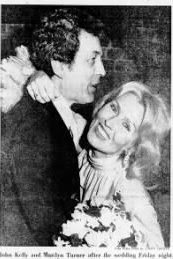Let's face it, folks! John Kelly was a Detroit television news second banana to Jac LeGoff at WJBK-Channel 2 and Bill Bonds at WXYZ-Channel 7 until he married Action News weathercaster Marilyn Turner. Together, they made Detroit television history when their popular morning show Kelly & Company ran for seventeen years. The live talk show was a mixture of show business gossip, fashion news, celebrity interviews, and the discussion of community issues of interest.
John William Kelin II was born in St. Louis, Missouri in 1927. He served as a radioman in World War II and again in Korea. After his enlistment was up, he worked as a TV program director and production manager in Rockford, Illinois before moving to WJBK in August 1965. John changed his birth surname to the more mainstream Kelly and began working as a field reporter before becoming co-anchor of WJBK's evening news program with senior correspondent Jac LeGoff. The toughest part of the job was having to laugh at LeGoff's tepid sense of humor.
In the 1970s at the direction of parent company American Broadcasting Company (ABC), WXYZ began an aggressive build-up of local news. Early in 1972, John Kelly jumped from WJBK-Channel 2 to WXYZ-Channel 7 and became co-anchor opposite Bill Bonds. Not long after, WWJ-Channel 4 fired Al Ackerman for editorializing on-air during his live sports broadcast. The popular sportscaster was swooped up by WXYZ. Then, later that year (October 1972), Marilyn Turner left WJBK to join the Channel 7 Action News team as a weathercaster five nights a week.
After seeing a newspaper ad referring to her as a weather girl, forty-one-year-old Turner let WXYZ management know she bristled at the weather girl label. "I don't believe any woman over 21 should be called a girl. You don't call a man a weather boy." The ad ran only once.
Marilyn Miller was born and bred in Windsor, Ontario across the river from Detroit. She was educated at Hugh Beaton Public School and graduated from Walkerville Collegiate before attending the University of Western Ontario at London where she studied psychology before switching to teaching. Subsequently, Marilyn married Dr. Robert Turner of Kitchener, Ontario. She began modeling and doing print ads for local retailers, first in Canada and then in the United States. In 1961 at the age of thirty, Turner became a weekend weathercaster at Detroit television station WJBK, known as "Miss Fairweather." She was still able to pursue her modeling and advertising career during the week.
While working at WJBK, Turner made a commercial that followed her throughout her years on television. She became the spokesperson for Carpet Center. Her ads appeared on all three Detroit television stations; they were broadcast on local radio stations throughout Detroit; and print ads appeared in local newspapers. One ad had Turner riding on a Persian carpet throughout the carpet warehouse. Her new contract with Channel 7 Action News prohibited their news personnel from making commercials, but her previous advertising work ran for many years, much to the annoyance of some viewers.

Initially, Turner was not a popular choice because she replaced familiar weatherman Jim Smith. Smith was Detroit's only genuine meteorologist and Turner had no experience except reading the weather from a script at her previous job. The outcry was so great that Smith made a public statement saying "Marilyn did what any person would do when they are offered a better job opportunity and more money." Smith quietly moved over to WJBK and took over their weather time slots.
Kelly and Turner met when they worked at WJBK, but it wasn't until Marilyn began working on the Action News team that they started dating. The couple kept their romance a secret as long as they could. They married on December 27, 1974 in a private home in Oxford, Michigan after their 6:00 pm newscast. The bride wore a salmon-colored, ankle-length dress and held a bouquet of roses and daisies. The groom wore a black suit with a gray vest. The newlyweds planned a Jamaican honeymoon between their next ratings period. Kelly (47) had three children from a previous marriage, and Turner (43) was married twice to Dr. Robert Turner and divorced him twice. She had a son from each marriage.

The triumph of hope over experience was a big enough challenge for the newlywed couple, but when the ABC network found out, the Kellys discovered there was a corporate policy against married couples working on the same TV news program. WXYZ had no such policy, but the chemistry of the new dynamic was palpable on the Action News set. The newspaper gossip columnists began referring to Kelly and Turner as the "Power Couple of Detroit." Even the station started to promote their news program that way.
But the wisdom of the policy was made apparent on Saturday, April 24, 1976 when Kelly moved into his own apartment due to domestic problems. Though the couple acted professionally on the air, the strain on the Action News team was perceptible. After fifteen months of separation and marriage counseling, John and Marilyn patched things up. He moved backed into their Farmington home.
Hoping to quell the persistent concerns of their parent ABC network, WXYZ pitched John Kelly the idea for a new type of live, morning program with a studio audience. At first, the Kelly & Company idea had no appeal for him. The rude awakening of getting up at 4:30 every morning was a deal breaker.
The station manager asked Kelly what it would take for him to change his mind. Kelly added terms to his contract he was sure would make his bosses look elsewhere for their daytime program host, but the station manager made Kelly an offer too good to refuse that included "more money, longer vacations, and out-of-state assignments." It was also a good move for his wife who was tired of doing the weather forecast.
When Kelly and Turner left Action News, John was making $175,000 as co-anchor and Marilyn was making $45,000 as weathercaster. Upon the debut of Kelly & Company on October 25, 1978, the couple signed a package deal for $500,000 a year. Kelly got $275,000 and Turner's salary jumped to $225,000.
The ninety-minute, live show was viewer friendly, community focused, and guest oriented. Co-hosts John Kelly and Marilyn Turner maintained an on-screen chemistry and lighthearted atmosphere that appealed strongly to women in the 18-40 year-old demographic. The show soon became first in its time slot, but in early June 1990, Kelly underwent emergency surgery for colon cancer and needed several months to recover. Turner stayed by her husband's side for two weeks while the station used various substitute hosts until her return.
Kelly returned to the show after his recovery and soldiered on for another four years until he announced on January 8, 1994 that he would be leaving the show on March 4th at the age of sixty-seven. Marilyn, now sixty-three-years-old, would continue the show without him.
The program was quickly reimagined. Former urban reporter for WXYZ, Nikki Grandberry, was hired to co-host. The show was rebranded Company with Marilyn Turner and Nikki Grandberry. As hard as these women worked to make their show a success, the Arbitron ratings fell off sharply. Detroit Free Press media columnist Bob Talbert pronounced on October 11, 1994 that Turner and Grandberry "are the most unmatched pair on (Detroit) television." As the saying goes, "If it don't gel, it ain't aspic." At the end of their contract period, WXYZ uncermoniously cancelled the program. Kelly & Company was the last Detroit-produced, non-news
program when it went off the air in 1995 after seventeen years serving Detroit's morning audience.
John Kelly passed away on September 18, 2016 at the Health and Living Center in Southfield, Michigan at the age of eighty-eight. Marilyn Turner passed away in mid-May, 2024 at the age of ninety-three. The exact date and cause of death was not revealed by her family.
Marilyn Turner interviews serial killer John Norman Collins from Marquette Prison














